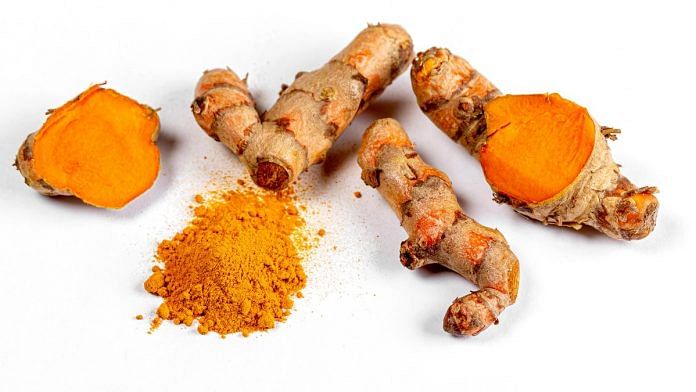New Delhi: In the year of the pandemic, the consumption of turmeric shot up as people across the country believed it to be a panacea to the risks of Covid-19.
The central government advocated using Ayurveda treatments such as turmeric milk, kadha and yoga for Covid prevention and treatment of patients with mild or no symptoms. And, the domestic demand for raw turmeric saw a jump of 300 per cent in 2020-21 from 2019-20.
This rise in consumption — which resulted in smaller carryover stock from last year — along with low crop production because of adverse weather in the two major turmeric-producing states saw its prices in markets across India shoot up.
In retail terms, compared to last month, price of whole turmeric and turmeric powder have both increased. While price of turmeric powder has increased to Rs 250-270/kg from Rs 200-230/kg, prices of whole turmeric has risen to Rs 85-100/kg from Rs 40-60/kg.
At the Sangli wholesale mandi, a major turmeric producing area, prices of best-quality turmeric crossed Rs 235 per kg on 8 March, which is nearly 70 per cent over the price of Rs 138/kg on the corresponding day last year, according to Maharashtra State Agricultural Marketing Board (MSAMB) data.
The average prices of the spice in the Sangli agricultural produce market committee also rose from Rs 99/kg to Rs 156/kg in the corresponding period, MSAMB data showed.
The rise also comes amid lower arrival in the wholesale market, with the daily figure in Sangli APMC, dropping from 48,531 quintal on 1 March — when the commodity prices were at Rs 210/kg — to 31,230 quintal on 8 March — when the prices surged to Rs 235/kg.
Moreover, the turmeric futures on National Commodity and Derivatives Exchange hit a fresh five-year high of Rs 9,336/quintal on 3 March.
Vinod Nagla, a spice trader in Nizamabad, Telangana, said, “Despite peak turmeric harvest season, arrivals of the new crop in Nizamabad mandi, the grade A prices are around 20-25 per cent higher compared to last year. Daily arrivals in Nizamabad are about 25,000 bags/day while it was 35,000 bags/day last year.”
He added, “The bulb variety of turmeric is being sold at Rs 6,250/quintal on 8 March, up from Rs 5850/quintal on 1 March whereas the finger variety is being sold at Rs 6,550/quintal against Rs 5,000/quintal last week.”
Also read: Look at petrol, diesel prices – not frothy stock markets – for health of Indian economy
Adverse weather issues
Speaking to ThePrint, Pramod Patil of Ankilkar Patil Trading Company in Sangli, which mainly deals in commodities such as turmeric, raisin and jaggery noted the reasons for this surge, including heavy rainfall in two major turmeric producing areas of Maharashtra and Telangana.
“Apart from the adverse weather, the turmeric prices are also running high due to a less carry overstock from last year because both the domestic consumption and export were record high in 2020 despite Covid-19 lockdown,” said Patil.
“Turmeric was in high demand across the country as soon as the unlock phase opened due to usage by people on the account of its medicinal properties. Similarly, the export of turmeric also shot up abroad as soon as freight traffic resumed replenishing the depleting stock caused by stringent lockdown across the world,” he said.
He said Maharashtra and Telangana also witnessed heavy rainfall at the end of 2020, which “destroyed the optimal development of crop bulbs in final stages”.
“The decline in arrival that we are witnessing now is caused by the damage caused by this bad weather leading to further increase in prices,” he added.
According to data from Agricultural and Processed Food Products Export Development Authority, Telangana and Maharashtra contribute over 50 per cent of India’s 8,89,000 tonnes of turmeric production. Telangana produces 2,94,560 tonnes of turmeric while Maharashtra produces 1,90,090 tonnes.
According to first advance estimate of horticulture crops by the Ministry of Agriculture, turmeric production is estimated to dip to 11,06,000 tonnes in 2020-21 from 11,53,000 tonnes in 2019-20.
“The production of turmeric is likely to decline by 10-15 per cent in major producing states such as Telangana, Andhra Pradesh and Maharashtra due to heavy deluge in these states last year which has hindered the development of bulbs in the crop due to waterlogging,” said an official from the Spices Board India, which comes under the Ministry of Commerce and Industry.
Telangana, Andhra Pradesh and Maharashtra received 511 per cent, 199 per cent and 131 per cent above-normal rains, respectively, the official said.
Carryover stock crisis
The overt usage of turmeric amid the Covid crisis in 2020 further led to a shortage of stock in the country, driven by a 42 per cent increase in the exports of turmeric between April and September 2020 to 99,000 metric tonnes, according to data from Spices Board India.
The board official quoted above said, “Carry-forward stock for the next season is estimated at 15 lakh bags (1 bag=65 kg). This is the lowest stock in the last three years which is further sustaining and increasing the price of commodities in the long run.”
Also read: Year after Nirmala’s ‘heartless SBI’ remark, nearly all Assam tea gardens get banking access






